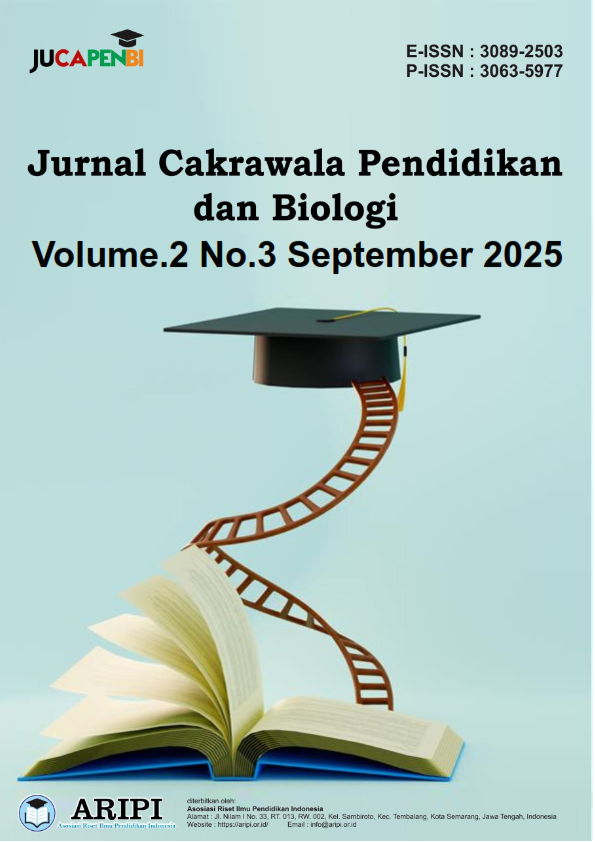Identifikasi Mikroorganisme dari Tempe Khas Bayung Lencir dengan Media PDA
DOI:
https://doi.org/10.61132/jucapenbi.v2i3.619Keywords:
Bayung Lencir, Potato Dextrose Agar (PDA), Rhizopus oligosporus, Tempeh, traditional fermentationAbstract
Tempeh, as one of Indonesia's traditional fermented foods, plays a vital role in providing affordable vegetable protein and contains various essential nutrients such as vitamin B12, folic acid, and fiber. Tempeh's uniqueness lies in the fermentation process involving local microorganisms that thrive in soybeans. Tempeh from Bayung Lencir, South Sumatra, is known for its traditional production process, which uses no starter culture. This results in a unique microbiota that has not been widely studied during fermentation. Therefore, this study focused on identifying the microorganisms involved in the tempeh fermentation process. The results showed that Rhizopus oligosporus is the primary microorganism responsible for the formation of tempeh's texture and increasing its nutritional value through the production of proteolytic and lipolytic enzymes that aid in the digestion of protein and fat. Furthermore, lactic acid bacteria such as Lactobacillus plantarum and Pediococcus spp. play a crucial role in creating a more acidic environment, thereby reducing the risk of pathogenic microorganism growth and maintaining product safety. However, an uncontrolled fermentation process can also result in contamination by harmful microorganisms, such as Aspergillus niger and Penicillium spp., which can affect the quality of tempeh and potentially produce mycotoxins that are harmful to health. The use of PDA media has proven effective in isolating and observing the morphological characteristics of fungi, such as colony color, texture, and growth rate. This medium provides adequate results in identifying microorganisms involved in the tempeh fermentation process. This research is important for maintaining the quality and safety of Bayung Lencir's signature tempeh and opens up opportunities for the development of local starter cultures that can improve quality control during the fermentation process. Molecular-based research is needed to further explore the identity of microbes and to improve the safety and competitiveness of tempeh in the global market.
References
Agistiana Azzahra, A. N., Al Toriq, M. R., & Sari, Y. A. F. (2024). Studi Penambahan Berbagai Jenis Tepung Terhadap Kualitas Starter Tempe Berdasarkan Parameter Lama Fermentasi. Jurnal Biotek, 12(1), 29–43. Https://Doi.Org/10.24252/Jb.V12i1.34313
Aini, N., & Rahayu, T. (2018). Media Alternatif Untuk Pertumbuhan Jamur Menggunakan Sumber Karbohidrat Yang Berbeda. Jurnal Ilmu Kesehatan, 3(5), 855–860.
Akses Diakses. (2025). Https://Microbiologyinfo.Com/Potato-Dextrose-Agar-Pda-Principle-Uses-Composition-Procedure-And-Colony-Characteristics/?Utm_Source=Chatgpt.Com
Asbur, Y., & Khairunnisyah. (2021). Tempe Sebagai Sumber Antioksidan: Sebuah Telaah Pustaka. Agriland Jurnal Ilmu Pertanian, 9(3), 183–192.
Atika, F. N. (2019). Identifikasi Rhizopus Sp Dan Aspergillus Sp Pada Tempe Yang Tersimpan Dalam Suhu Ruang (Studi Di Laboratorium Mikrobiologi Stikes Icme Jombang) (Doctoral Dissertation, Stikes Insan Cendekia Medika Jombang).
Dewi, R. S., & Aziz, S. (2011). Isolasi Rhizopus Oligosporus Pada Beberapa Inokulum Tempe Di Kabupaten Banyumas. Molekul, 6(2), 93-104. Https://Doi.Org/10.20884/1.Jm.2011.6.2.97
Dewi, R. S., & Aziz, S. (2011). Isolasi Rhizopus Oligosporus Pada Beberapa Inokulum Tempe Di Kabupaten Banyumas. Molekul, 6(2), 93. Https://Doi.Org/10.20884/1.Jm.2011.6.2.97
Farisa Novi Atika, & Awaluddin Susanto. (2019). Identifikasi Rhizopus Sp Dan Aspergillus Sp Pada Tempe Yang Tersimpan Dalam Suhu Ruang (Studi Di Laboratorium Mikrobiologi Stikes Icme Jombang). Jurnal Insan Cendekia, 6(2), 83–89.
Irawati, W. (2021). Praktikum Pembuatan Medium Potato Dextrose Agar Secara Sederhana Dan Isolasi Jamur Pada Biji-Bijian Yang Dilakukan Secara Online. BIO-EDU: Jurnal Pendidikan Biologi, 6(3), 289–299.
Karamally, T., & Robertson, J. L. (2023). Green Leadership. In The Handbook Of Climate Change Leadership In Organisations: Developing Leadership For The Age Of Sustainability (Pp. 179–202). Https://Doi.Org/10.4324/9781003343011-11
Kustyawati, M. E. (2009). Kajian Peran Yeast Dalam Pembuatan Tempe. Agritech, 29(2), 64–70.
Puspadewi, R., Adirestuti, P., & Anggraeni, G. (2011). Aktivitas Metabolit Bakteri Lactobacillus Plantarum Dan Perannya Dalam Menjaga Kesehatan Saluran Pencernaan. Konferensi Nasional Sains Dasar Dan Aplikasinya, June, 1–11.
Sine, Y., & Soetarto, E. S. (2018). Isolasi Dan Identifikasi Kapang Rhizopus Pada Tempe Gude (Cajanus Cajan L.). Savana Cendana, 3(04), 67–68. Https://Doi.Org/10.32938/Sc.V3i04.487
Tamam, B. (2022). Tempe: Pangan Lokal Unggul (Superfood) Khasanah Budaya Bangsa. Indonesian Red Crescent Humanitarian Journal, 1(1), 41–48. Https://Doi.Org/10.56744/Irchum.V1i1.14
Yuliana, R., & Taufiq Qurrohman, M. (2022). Pengaruh Variasi Konsentrasi Sari Pati Buah Sukun Sebagai Alternatif Media Semi Sintetik Pada Pertumbuhan Jamur Candida Albicans. Jurnal Of Indonesian Medical Laboratory And Science, 3(1), 65–79.
Downloads
Published
How to Cite
Issue
Section
License
Copyright (c) 2025 Jurnal Cakrawala Pendidikan dan Biologi

This work is licensed under a Creative Commons Attribution-ShareAlike 4.0 International License.






